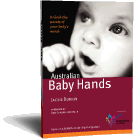Baby Sign Language Research
Over the last two decades there has been numerous research conducted around the topic of baby sign language. Below is a list of studies/research/articles on baby sign language that highlight the various benefits of using baby sign language in your home or childcare centre.
Using Sign Language With Hearing Children (Babies, Pre-School & Primary aged Children)
Acredolo & Goodwyn:
Acredolo & Goodwyn conducted over twenty years of research on the benefits of using simple hand movements with pre-verbal babies. Below is a link to their three main studies:
- Susan Goodwyn, Linda Acredolo, and Catherine Brown (2000). Impact of symbolic gesturing on early language development. Journal of Nonverbal Behavior, 24 (2), pp. 81-103.
Article – Impact of Symbolic Gesturing on early language development - Acredolo, L. P., & Goodwyn, S.W. (July 2000). The long-term impact of symbolic gesturing during infancy on IQ at age 8. Paper presented at the meetings of the International Society for Infant Studies, Brighton, UK.
Article – The long-term impact of symbolic gesturing during infancy on IQ at age 8 - Brie Moore, Linda Acredolo, & Susan Goodwyn (April 2001). Symbolic gesturing and joint attention: Partners in facilitating verbal development. Paper presented at the Biennial Meetings of the Society for Research in Child Development.
Article – Symbolic gesturing and joint attention
Marilyn Daniels:
Dr. Marilyn Daniels, a professor of communication arts and sciences at Penn State University, is a distinguished researcher and a recognized authority of studying the benefits of teaching sign language to children in preschool through sixth grade. Below are a list of her studies, books and journal entries:
-
- “ASL as a Possible Factor in the Acquisition of English for Hearing Children,” Sign Language Studies, 1993, Vol. 78, pp. 23-29.
- “The Effect of Sign Language on Hearing Children’s Language Development,” Communication Education, 1994, Vol. 43:4, pp. 291-298.
- “Words More Powerful Than Sound,” Sign Language Studies, 1994, Vol. 83, pp. 155-166.
- “Nonverbal Language and Manual Speech,” The Speech Communication Annual, 1994, Vol. 8, p. 51-60.
- “Seeing Language: The Effect Overtime of Sign Language on Vocabulary Development in Early Childhood Education,” Child Study Journal, 1996, Vol. 26:3, pp. 193-208.
- “Previously Masked Concepts: The Communicative Role of Language in Deaf and Hearing Cultures,” Ohio Speech Journal, 1996, Vol. 34, pp. 1-15.
- “Previously Masked Concepts: The Communicative Role of Language in Deaf and Hearing Cultures,” Ohio Speech Journal, 1996, Vol. 34, pp. 1-15.
- “Teacher Enrichment of Prekindergarten Curriculum with Sign Language,” Journal of Research in Childhood Education, 1997, Vol. 12:1, pp. 27-33.
- Sign Language Advantage. Sign Language Studies. Vol.2:1, 2001, pp.5-19.
Sign Education: A Communication Tool for Young Learners. Speech Communication Association of Pennsylvania Annual. Vol.LVII, 2001, pp.77-95. - Reading Signs: A Way to Promote Early Childhood Literacy. Communication Teacher. Vol. 16:2, 2002, pp.32-38.
- Using A Signed Language as a Second Language for Kindergarten Students. Child Study Journal. Vol.33:1, 2003, 2003, pp. 53-70.
- Happy Hands: The Effect of ASL on Hearing Children’s Literacy. Reading Research and Instruction. Vol. 44:1 Fall 2004, pp.86-100.
- Deaf President Now and American Sign Language: Seeing Rhetoric. Pennsylvania Communication Association Annual. 2005, (in press).
- The Silent Signs of Learning: ASL in a Special Needs Class. Child Study Journal. 2005, (in press).
- Daniels, M. (2001). Dancing with Words: Signing for Hearing Children’s Literacy. Westport, Connecticut: Bergin and Garvey.
Other Researchers & Articles:
-
- Wilson, R., Teague, J., and Teague, M. (1985). The Use of Signing and Fingerspelling to Improve Spelling Performance with Hearing Children. Reading Psychology, 4, 267-273.
- Hafer, J. (1986). Signing For Reading Success. Washington D.C.: Clerc Books, Gallaudet University Press.
- Koehler, L., and Loyd, L. (September 1986). Using Fingerspelling/Manual Signs to Facilitate Reading and Spelling. Biennial Conference of the International Society for Augmentative and Alternative Communication. (4’th Cardiff Wales).
- “The Effect of Singing Paired with Signing on Receptive Vocabulary Skills of Elementary ESL Students”, Heather A. Schunk, Journal of Music Therapy: Vol. 36, No 2, pp. 110-124.
- Sign Language: The Best Second Language? By Steve Kokette
- Hearing Students, Sign Language, and Music: A Valuable Combination By Steve Kokette
- “Sign, Baby, Sign!” by Kristin Snoddon, Article in World Federation of Deaf News, May 2000, pp. 16-17.
https://www.handspeak.com/tour/kids/index.php?kids=signbabysign
Using Sign Language With Children Who Have Reading Disabilities:
- Vernon, M., Coley, J., Hafer, J., and Dubois, J. (April 1980). Using Sign Language to Remediate Severe Reading Problems. Journal of Learning Disabilities, 13, 215-218.
- Blackburn, D., Vonvillian, J., and Ashby, R. (January 1984). Manual Communication as an Alternative Mode of Language Instruction for Children with Severe Reading Disabilities. Language, Speech and Hearing Services in Schools, 15, 22-31.
- Carney, J., Cioffi, G., and Raymond, W. (Spring 1985). Using Sign Language For Teaching Sight Words. Teaching Exceptional Children. 214-217.
- Sensenig, L., Topf, B., and Mazeika, E. (June 1989). Sign Language Facilitation of Reading with Students Classified as Trainable Mentally Handicapped. Education and Training of the Mentally Retarded, 121-125.
